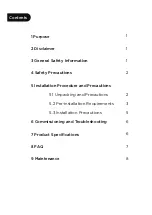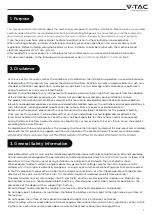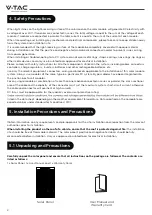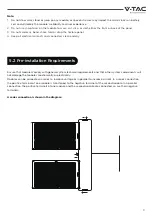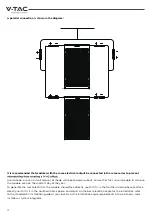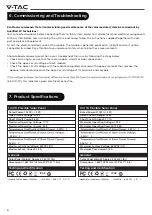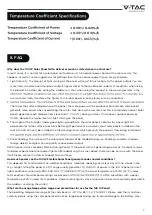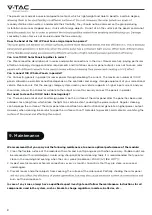
7
8. FAQ
Why does the 100 W Solar Panel fail to deliver as much as stated when in actual use?
In most cases, it is normal for a solar panel not to deliver its full nominal power. Some of the reasons why this
happens, as well as some suggestions for getting closer to the nominal power figure, are given below.
1. Light Intensity. The amount of light shining on the panel will result in fluctuations to the power output. You are
more likely to achieve nominal power output figures closer to those obtained under test conditions when using
the product on a clear day during the midday sun, than when using the product in the morning or later in the
are much less likely to achieve the figures for nominal power in hazy, cloudy or rainy conditions.
2.
The lower the surface temperature of the panel, the more power will be produced. For example, solar panels
generate more power when used during the winter than during the summer, and this is completely normal. Solar
panels generally reach temperatures close to 60 °C (140°F) during summer. This reduces nominal power by
10–15%, despite the higher levels of light shining on the panel.
3. The Angle of the Sunlight. Under good lighting conditions, the solar panel is able to stay where light hits
perpendicular to the surface to achieve better light performance. However, most solar panels installed on the
roof of an RV can only be installed in a tiled configuration, which prevents the panel(s) from being installed at
4. Panel Shading. The surface of the solar panel should not be shaded during use. Shading caused by shadows,
foreign objects and glass can all greatly reduce power output.
Performance Issues caused by Malfunctioning Panels: If the panel still isn't generating power or its output remains
far below expected nominal power figures after addressing the issues above, there may be an issue with the panel
itself. Please contact Customer Support for assistance.
How much power can the 100 W Flexible Solar Panel generate under normal conditions?
This depends first and foremost on weather conditions. Generally speaking, on a clear day with no clouds in the
sky, sunlight hitting the panel at a 90° angle usually generates 70 W–80 W of power in the 100 W panel (current
light conditions are normally 800–900 W/m
2
(74.3–83.6 W/ft
2
) with a panel temperature of 50°C (32°F) under
test conditions. Nominal power ratings are based on 1,000 W/m2 (92.9 W/ft
2
) in AM1.5 conditions with a panel
temperature of 25°C under test conditions. Power output figures close to nominal values were normally observed in
the midday sun during the winter).
What are the usage temperature range and precautions for use for the 100 W Panel?
The operating temperature range of the solar panel is -20°C to 85°C (-4°F to 185°F). Please read the instructions
carefully before using the solar panel and minimize large bends during use to avoid damage to the battery core.
-(0.39+/-0.02)%/k
-(0.33+/-0.03)%/k
+(0.06+/-0.015)%/k


